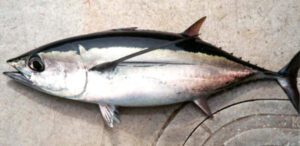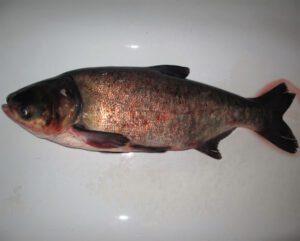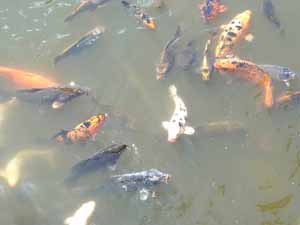The Nile perch fish is a species of freshwater fish which is widespread throughout much of the Afrotropic ecozone. It is native to the Nile, Niger, Congo and Senegal and also found in Lake Chad, Lake Turkana, Volta and other river basins. It is also found in the brakish waters of Lake Maryut in Egypt.
The Nile perch fish is also known by some other names. And it’s common names include Victoria perch, African snook and many other different local names.
Some of the local names are Mbuta or Mputa in Luo, Sangara, Sankara or Chenku in Tanzania. It is known as Capitaine in Francophone African countries, and called as am’kal in Egypt/Sudan.
The fish is called as Giwan Ruwa in the Hausa language which means ‘water elephant‘. Read some more information about this fish species below.
Nile Perch Fish Characteristics
The Nile perch fish has an elongated, compressed and deep body. It is mainly silver in color with a blue tinge. It has distinctive dark-black eyes, with a bright-yellow outer ring.
Head with concave snout profiles, opercule with one spine. Dorsal fin of this fish bipartite with 7 to 8 spines on the first part, and 1 spine and 8-11 soft rays on the second. The anal fin is with 3 spines and 6-9 soft rays, and the caudal fin is rounded.
Average body length of the mature fish is between 121 and 137 cm, with a maximum length of nearly 2 meters. The mature fish can reach up to 200 kg. Photo and info from EOL and Wikipedia.

Diet
The Nile perch fish are feed on fish, crustaceans and insects. They can occasionally eat their own species. The juveniles are also feed on zooplankton.
Uses
The Nile perch fish is mainly used for food. It is also popular with sport anglers, because it attacks artificial fishing lures. And the fish is also raised in aquaculture.
Special Notes
The Nile perch fish is commercially a very important fish species. It is used mainly for food. It inhabits a wide variety of habitats, including lakes, rivers and irrigation channels. It is somewhat restricted from entering swamps, because it is relatively intolerant of low-oxygen waters.
The fish is caught mainly with bottom trawls, seines, handlines, traps and gillnets. It is consumed pan-fried, broiled, steamed and baked. However, review full breed profile of this fish in the table below.
| Name | Nile Perch |
| Kingdom | Animalia |
| Phylum | Chordata |
| Class | Actinopterygii |
| Order | Perciformes |
| Family | Latidae |
| Genus | Lates |
| Species | L. niloticus |
| Binomial Name | Lates niloticus |
| Other Names | Also known as Victoria perch, African snook |
| Breed Purpose | Mainly food |
| Special Notes | Economically important fish species, used mainly for food, can be very large in size |
| Weight | Can reach up to 200 kg |
| Breeding Method | Natural |
| Climate Tolerance | Native climates |
| Body Color | Mainly silver with a blue tinge |
| Rarity | Common |
| Availability | Africa |





